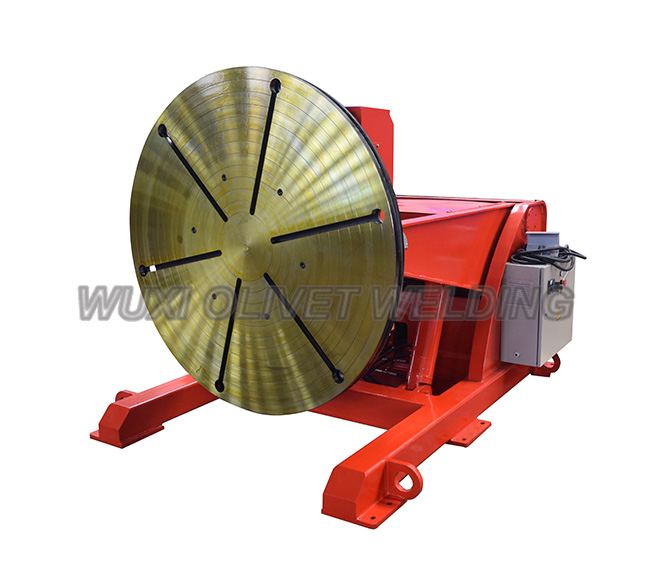
E-mail:sales@chinaolivet.cn

The robot welding positioner is a special welding auxiliary equipment for welding robots. It is suitable for the welding position of the rotary work to obtain the ideal processing position and welding speed. The purpose is to facilitate the welding work and is loved by many customers. The positioner can be used in conjunction with the operating machine and the welding machine to form an automatic welding center, and it can also be used for manual workpiece displacement. The table rotation adopts frequency converter step-less speed regulation, with high-speed regulation accuracy. The remote control box can realize the remote operation of the workbench, and can also be connected with the operating machine and the welding machine control system to realize the linkage operation.
The hydraulic welding positioner is generally composed of a worktable rotating mechanism and a turning mechanism. Through the lifting, turning, and turning off the worktable, the workpieces fixed on the worktable can reach the required welding and assembly angles. The worktable rotation is variable frequency step-less adjustment Speed, you can get a satisfactory welding speed.

Hydraulic Welding Positioner
How to choose a matching robot welding positioner?
1. The weight of the hydraulic welding positioner, the center of gravity, and the eccentricity of the weldment on the entire work surface, should be within the corresponding data range, and a certain capacity must be ensured.
2. If the optional robot welding positioner is for circumferential seam welding, the rotation speed should be considered according to the groove of the weldment. The speed should be within the range of the positioner rotation speed adjustment. Can the platform's stable operation requirements satisfy the entire process?
3. If the size of the entire weldment of the robot welding positioner is relatively large on the outer contour, then the inclination of the worktable needs to be considered, or whether the tilt angle can meet the best welding position of the weldment, etc. When the inclined angle and the weldment are in contact, then when selecting the workbench, it needs to have a larger gap from the ground, so as to ensure the entire welding processing requirements.
4. When you need to start the robot welding positioner, install the electromagnetic fixture and water-cooling equipment, you should first adjust it with the manufacturer.
5. For the welding current requirements of the robot welding positioner, the welding parts with a relatively large current are required.
Classification of robot welding positioner
Robot welding positioner is mainly divided into DC motor positioner, AC motor positioner, stepper motor positioner, servo motor positioner, etc.
Features of DC motor robot welding positioner
Used for light welding positioner, 0-360 degree rotation, 0-90 degree flip, step-less speed change, timing function, welding machine linkage, anti-electromagnetic interference.
Features of AC motor robot welding positioner
Used for heavy welding positioner, 0-360 degree rotation, 0-135 degree flip, step-less speed change, welding machine linkage, anti-electromagnetic interference.
Features of stepper motor robot positioner
PLC programming can be carried out according to customer requirements, 0-360 degree rotation can be set, the speed can be set accurately, 0-90 degrees flip, timing function, welding machine linkage, anti-electromagnetic interference.
Features of servo motor robot welding positioner
It has all the characteristics of a stepper motor, which is more accurate than a stepper motor and can be used with a welding robot.
We are a welding equipment supplier, if you are interested in our products, please feel free to contact us.
Wuxi OLIVET Machinery Equipment Co.,LTD.E-mail: sales@chinaolivet.cnTel: +86-510-8383 0908
Home About UsProductsQuality ControlCompany NewsContact Us Sitemap
Copyright©2015 Wuxi OLIVET Machinery Equipment Co.,Ltd. Technical Support: Reanod